You’ll master mixed metal chain design through seven key techniques: graduated metal shifts that seamlessly blend different metals, textural contrasts pairing matte and polished finishes, asymmetrical link patterns with varying sizes, wire wrapping integration for distinctive connections, soldered joint strategies for durability, patina and oxidation enhancement for depth, and strategic gemstone accent placement. These methods create visual flow, dramatic interplay, and dynamic movement in your pieces. Master these approaches to transform ordinary chains into extraordinary wearable art.
Graduated Metal Transition Techniques
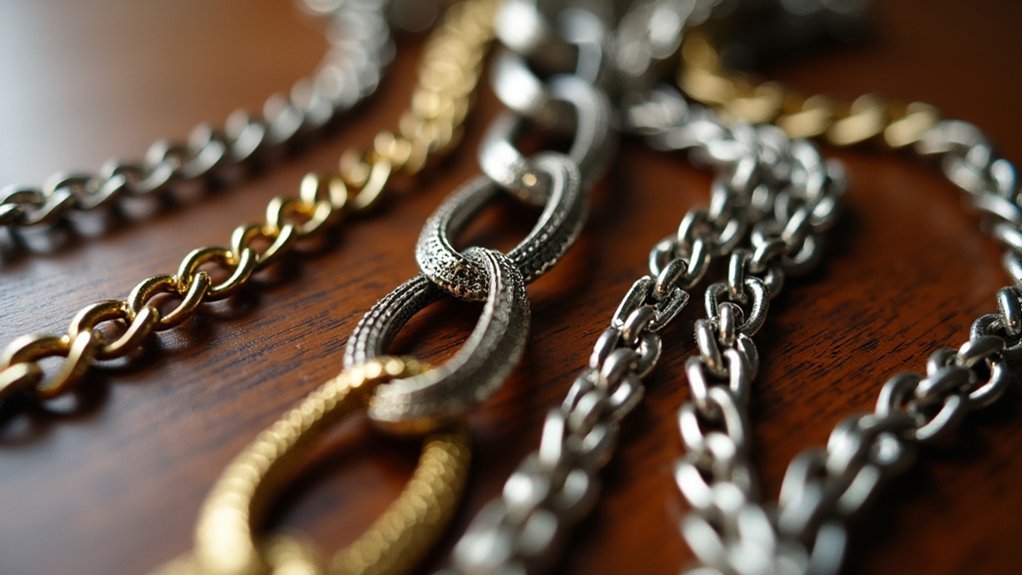
Three fundamental approaches define graduated metal transformation techniques in chain design: seamless blending, textural contrast, and proportional scaling.
You’ll achieve the best results by starting with one base metal like gold, then gradually incorporating silver or rose gold in varying lengths throughout your piece. This mixing metals approach creates natural visual flow that enhances your overall look.
Consider pairing different finishes—matte gold with polished silver adds remarkable dimension to your design.
Mixing matte and polished finishes creates stunning visual depth that transforms simple metal combinations into sophisticated, eye-catching jewelry pieces.
You can also experiment with varying link sizes and chain thicknesses to emphasize metal contrasts and draw the eye naturally along the piece.
Adding gemstones or colored accents at shift points unifies your mixed metals beautifully, creating a cohesive graduated effect that establishes your unique style.
Textural Contrast and Finish Combinations
You’ll discover that contrasting matte and polished finishes creates striking visual depth in your mixed metal chains.
When you pair a lustrous polished silver cable chain with oxidized gold links, you’re establishing dramatic textural interplay that catches light differently across each surface.
Mixing cable chains with rope-textured elements amplifies this effect, as the smooth, geometric lines of cable work beautifully against the organic, twisted patterns of rope chains.
Matte Vs Polished Effects
When you’re designing mixed metal chains, the contrast between matte and polished finishes creates one of the most powerful visual dynamics at your disposal.
Matte finishes provide subtle, understated elegance that softens your mixed metal design, while polished finishes reflect light dramatically, creating striking focal points.
Combining these contrasting textures transforms how each metal presents itself. You’ll find that matte gold paired with polished silver enhances visual contrast while showcasing each metal’s unique characteristics through dynamic textural interplay.
Consider these strategic approaches:
- Layer varying degrees of matte and polished effects within the same piece for exceptional depth.
- Use matte textures to convey modern, rustic moods in your designs.
- Apply polished finishes when you want to evoke sophistication and elegance.
- Experiment with light interaction to understand how finishes affect the wearer’s tactile experience.
Cable and Rope Mixing
Cable and rope chains represent two fundamentally different approaches to metal construction that, when combined, create extraordinary visual tension in your mixed metal designs. You’ll discover that cable chains’ smooth, rounded profiles perfectly complement rope chains’ twisted, textured surfaces, producing striking contrast that elevates your jewelry’s aesthetic appeal.
When mixing metals like gold and silver, you’re adding contemporary edge to traditional styles. Layered design becomes particularly effective when you experiment with different proportions and lengths, creating dynamic movement between textures.
| Chain Type | Finish Option | Visual Effect | Metal Pairing | Length Variation |
|---|---|---|---|---|
| Cable | Matte | Subtle depth | Gold primary | Short accent |
| Rope | Polished | High contrast | Silver primary | Medium base |
| Cable | Polished | Clean lines | Mixed equally | Long statement |
| Rope | Matte | Soft texture | Gold accent | Graduated |
| Combined | Mixed finishes | Maximum impact | Alternating | Asymmetrical |
Asymmetrical Link Pattern Development
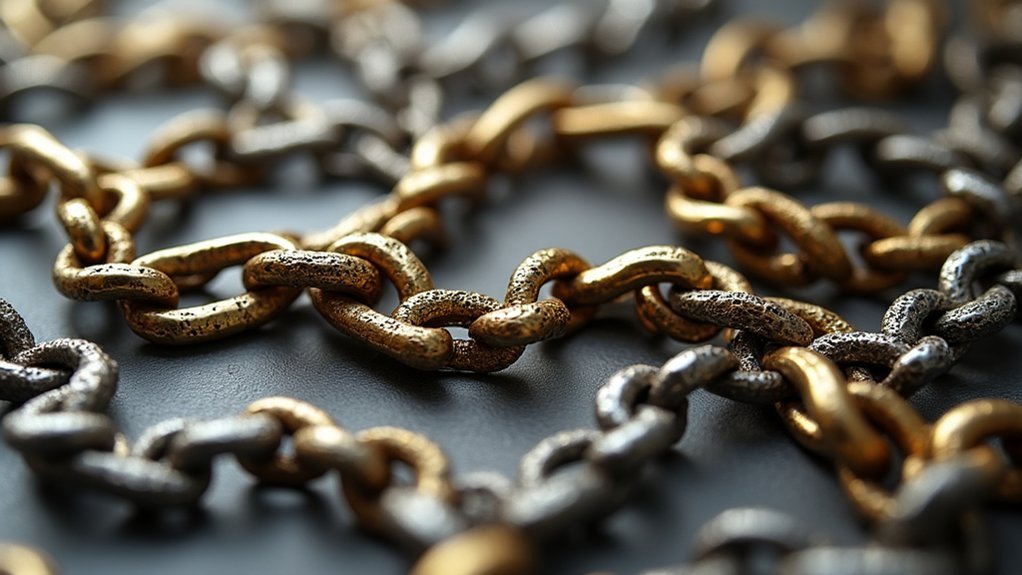
You’ll create visual dynamism in your mixed metal chains by implementing graduated link sizing that shifts from small to large elements throughout the piece.
Alternating metal placement between gold and silver links establishes rhythmic contrast while preventing monotonous patterns from developing.
Irregular chain rhythms break conventional expectations by varying the spacing and sequencing of your links, resulting in sophisticated asymmetrical designs that capture attention.
Graduated Link Sizing
Asymmetry becomes your most powerful design tool when you’re creating chains with graduated link sizing.
You’ll transform ordinary jewelry pieces into enchanting focal points by varying link dimensions throughout your design. Starting with larger centerpiece links and gradually reducing sizes toward the ends creates natural visual flow that draws attention exactly where you want it.
This technique works beautifully with mixed metals, allowing you to blend different colors and textures while maintaining a harmonious look across the entire piece.
- Combine oval and round shapes within your graduated sequence for enhanced organic appeal
- Experiment with link spacing to create rhythmic movement throughout the chain
- Layer different metal tones strategically within the size progression
- Balance proportions carefully to guarantee smooth shifts between link sizes
Alternating Metal Placement
Three distinct approaches to alternating metal placement will revolutionize your chain-making process and create stunning asymmetrical patterns that captivate viewers.
You’ll discover that strategically positioning gold and silver pieces creates dynamic visual interest while maintaining cohesive flow throughout your design.
Start by experimenting with varied textures and finishes between your mixed metals. This contrast adds remarkable depth while preventing monotony.
Next, incorporate different link sizes and shapes within your alternating pattern, creating dimension that catches light beautifully.
Balance remains essential—harmonize proportions throughout your chain so no single element dominates.
Adjust spacing between metals to achieve your desired rhythm. These techniques work exceptionally well for layering necklaces, where asymmetrical patterns complement multiple pieces worn together, showcasing your personal style.
Irregular Chain Rhythms
When you break away from predictable patterns and embrace intentional irregularity, your chain designs transform from ordinary to extraordinary.
Irregular chain rhythms create visual interest through deliberate asymmetrical patterns that captivate viewers and showcase your artistic vision.
You’ll achieve dynamic results by mixing metals like gold and silver to enhance contrast and depth in your asymmetrical pattern. The key lies in varying link sizes, alternating between bold statement pieces and delicate connectors.
Here’s how to master irregular chain rhythms:
- Vary link dimensions – Combine oversized links with petite ones for playful sophistication
- Apply diverse textures and finishes – Mix matte, polished, and hammered surfaces for emphasis
- Experiment with spacing – Adjust gaps between links for improved movement and flow
- Layer contrasting metals – Strategically place different metal types throughout your design
Wire Wrapping Integration Methods
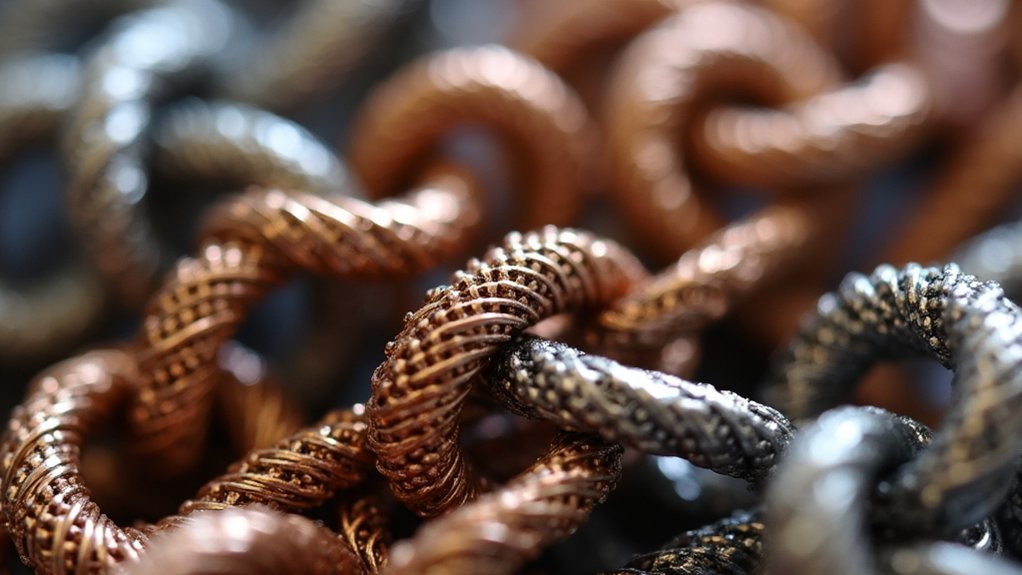
Since wire wrapping transforms ordinary mixed metal chains into distinctive artistic statements, you’ll find this technique vital for creating seamless connections between different metals and materials.
You can secure gemstones or beads directly within your chain links, creating enchanting focal points that integrate effortlessly with your mixed metals design.
Experiment with varying wire gauges to achieve different textures and visual interest throughout your piece.
Try incorporating simple loops or spirals in contrasting metals to add dimensional complexity.
Master techniques like figure-eight wraps or basic coils to create dynamic connecting links between different chain components.
Always make sure your wire wrapping remains tight and secure while maintaining flexibility for natural movement.
This balance preserves your piece’s integrity while allowing the graceful drape that makes mixed metal chains so appealing.
Soldered Joint Connection Strategies
Although wire wrapping creates beautiful artistic connections, soldered joints offer the ultimate strength and permanence for your mixed metal chain designs.
When working with mixed metals like silver and gold, you’ll need to master specific strategies for creating durable connections that withstand daily wear.
Here are four essential soldered joint strategies for mixed metal chains:
- Match your solder type – Use silver solder for silver components and gold solder for gold elements to guarantee proper bonding.
- Prepare surfaces meticulously – Clean all metal thoroughly and apply flux to prevent oxidation during heating.
- Control heat distribution – Heat joints evenly to avoid warping delicate chain links.
- Pickle after soldering – Remove flux residues and oxidation for a professional, polished finish.
These techniques guarantee your mixed metal creations maintain structural integrity while preserving their aesthetic appeal.
Patina and Oxidation Enhancement

While soldered joints provide the structural foundation for your mixed metal chains, patina and oxidation techniques add the artistic soul that transforms ordinary metalwork into extraordinary jewelry.
You’ll discover that controlled patina applications introduce stunning blues, greens, and browns that either complement or dramatically contrast your primary metal tones.
Accelerate oxidation using chemical solutions like liver of sulfur, which darkens silver and creates rich textural depth in your mixed metal jewelry.
Each application yields different results based on environmental factors and your technique, ensuring you’ll create truly unique pieces every time.
Remember that patina requires ongoing care—moisture and abrasive materials can alter your finish.
Plan regular maintenance to preserve your artistic vision and keep your chains looking their absolute best.
Gemstone Accent Placement Principles
When you position gemstones thoughtfully within your mixed metal chains, you transform functional jewelry into enchanting wearable art that commands attention.
Strategic placement creates visual hierarchy while harmonizing different metals through coordinated color choices that echo each material’s natural tones.
Your gemstone selection directly impacts the overall design impact:
- Place larger statement stones at focal points like chain centers to anchor the composition.
- Use complementary colors that seamlessly blend with your chosen metals’ undertones.
- Vary stone placement patterns between clustered groupings and evenly distributed spacing for dynamic movement.
- Mix different cuts like faceted and cabochon styles to introduce diverse textures alongside your metal combinations.
Consider how size and shape relationships affect visual balance, using smaller accent stones to add subtle interest while larger pieces command attention.
Frequently Asked Questions
How to Style Mixed Metal Jewelry?
Start with one dominant metal, then layer different lengths and textures. Balance bold statement pieces with delicate accessories. Mix matte and polished finishes, and add gemstones that complement your metals for personalized flair.
Are Mixed Metals Still in Style?
Yes, you’ll find mixed metals are definitely still trending. They’re everywhere from runway shows to everyday wear. You can easily mix gold, silver, and rose gold pieces to create versatile, modern looks that work with any outfit.
How Do You Mix Metals Successfully?
You’ll mix metals successfully by choosing one dominant metal as your base, then adding complementary secondary metals. Balance statement pieces with simpler accessories, and use gemstones to unify different metals together.
Why Can’t Gold and Silver Mix?
You can’t mix gold and silver according to traditional rules because their warm and cool tones clash, creating visual discord that appears unrefined and breaks established style conventions favoring singular metal elegance.
In Summary
You’ve now mastered seven powerful techniques for creating stunning mixed metal chains. Don’t be afraid to combine multiple methods in a single piece—layer textural contrasts with asymmetrical patterns, or integrate wire wrapping with strategic patina placement. Remember, you’re not bound by traditional rules. Experiment with unexpected metal pairings and let your creativity guide the design process. Your unique mixed metal chains will showcase both technical skill and artistic vision.

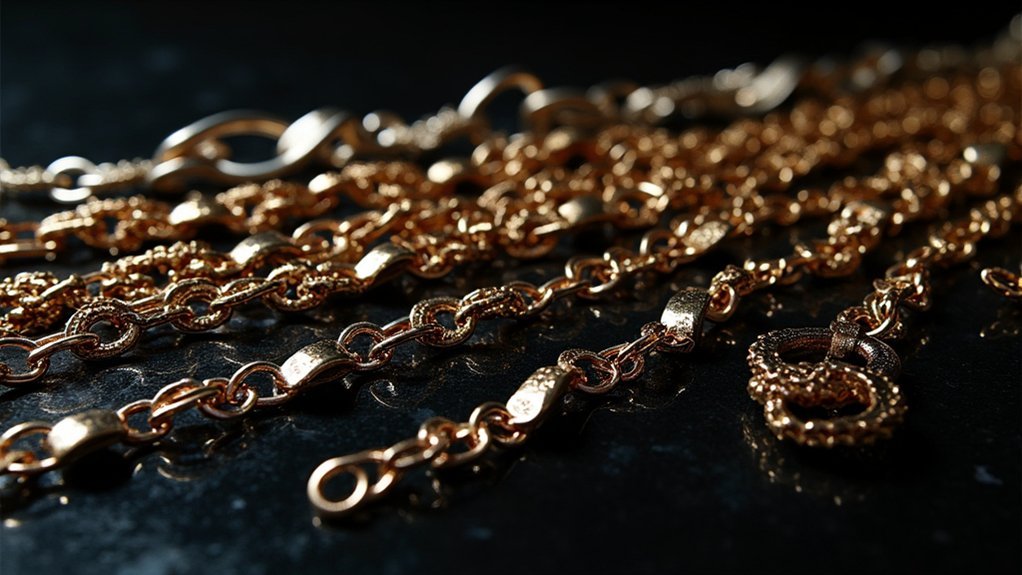

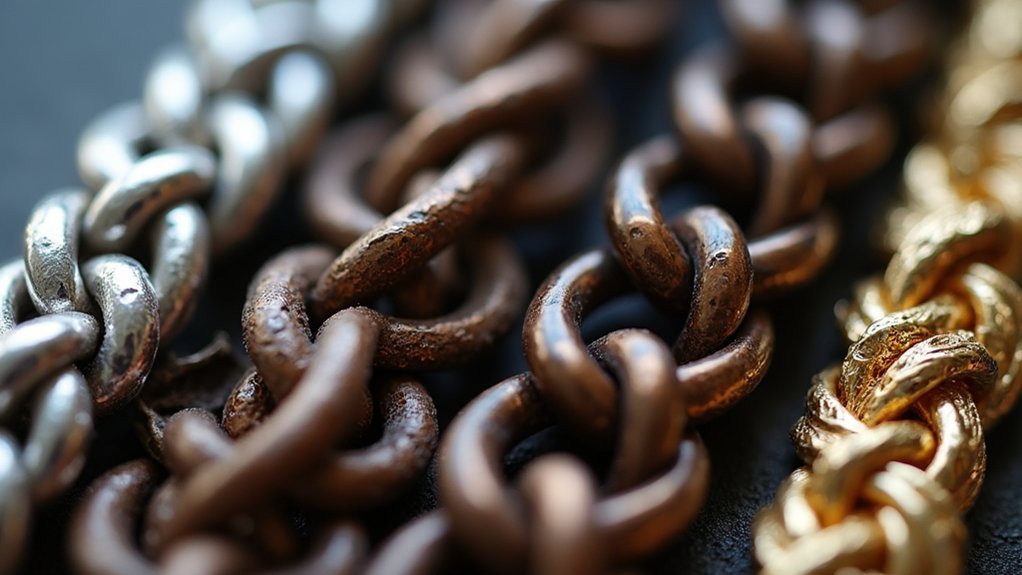
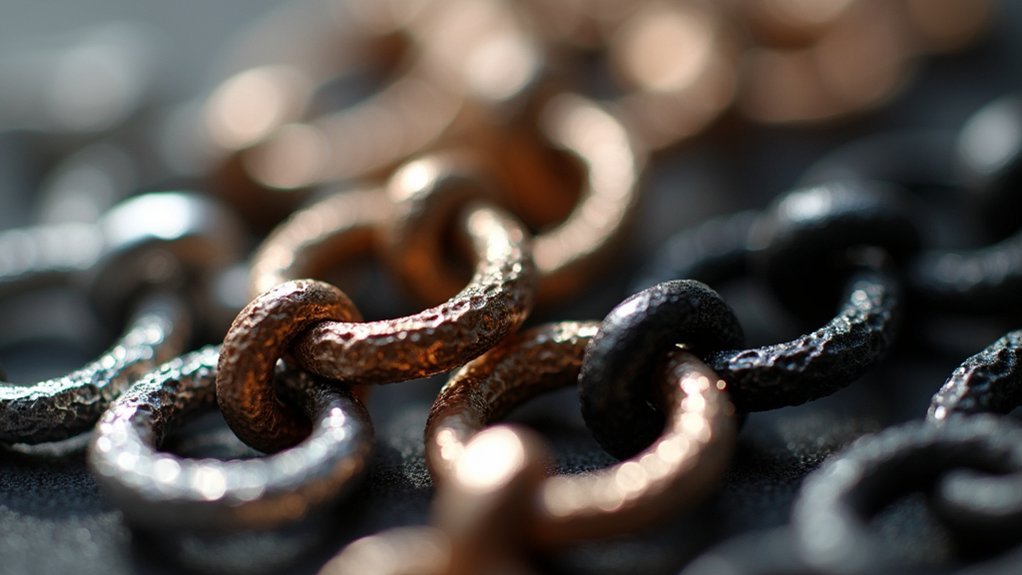
Leave a Reply